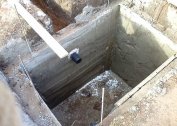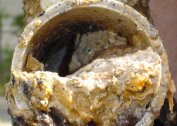A clogged sewer pipe is always unpleasant. Especially when it happens unexpectedly. But you can cope with this problem yourself. There are tons of ways you can learn from this article.
The root causes of the problem
 Before you fix a problem, you need to understand the reasons why it happened. This will help to avoid trouble in the future.
Before you fix a problem, you need to understand the reasons why it happened. This will help to avoid trouble in the future.
The main causes of blockage are as follows.
- Old cast-iron pipes. They are susceptible to corrosion and salt deposits appear inside. As a result, the cross-sectional area decreases, and the surface becomes rough. Trash clings to it very well.
- Fat sticking to the inside of the pipes. It gets into the sewer every time you wash the dishes, and large accumulations can completely clog the pipe. Especially when garbage, food waste and so on stick to it.
- Mechanical plug. It is formed if foreign objects that do not dissolve get into the pipe. For example, hair or cat litter.
- Incorrect pipe routing. The abundance of elbows, bends and angles provokes frequent clogging of the pipe, it is in them that deposits are first collected.
This leads to the following consequences:
- bad smell;
- decrease in the rate of water leaving;
- raising the level of wastewater in the system.
If you do not take action, then the pipe will clog completely.
We determine the place of blockage
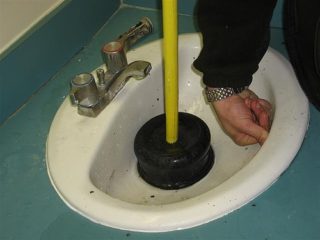 Most often, clogging occurs in the bends of sewer pipes and their joints. Typically, water accumulates:
Most often, clogging occurs in the bends of sewer pipes and their joints. Typically, water accumulates:
- in a siphon or corrugated discharge;
- in a riser or in the basement of an apartment building;
- at the exit of the pipe from a private house at the installation site of the inverse filter;
- between the wells.
Independently, the place of blockage can be determined by the rate of water departure. To do this, open the tap and see how quickly its level drops.
- the water leaving speed is large, and then decreases - the site is clogged at a distance of more than 1.5 m .;
- the water level drops slightly, and then becomes constant - the area from the siphon to the first turn is clogged;
- water does not flow anywhere - a siphon is clogged.
After you have identified the blockage, you need to choose the best cleaning method.
Methods for cleaning pipes and instructions for them
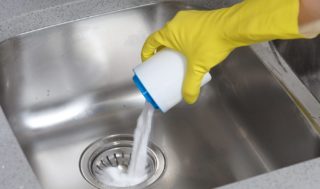 Chemicals for cleaning sewer pipes give a quick and high-quality result. The most popular means are “Mole”, “Domestos”, “Tiret” and “Tiret Turbo”, as well as “Mr. Muscle” and others. They are available both in liquid form and in powder form.
Chemicals for cleaning sewer pipes give a quick and high-quality result. The most popular means are “Mole”, “Domestos”, “Tiret” and “Tiret Turbo”, as well as “Mr. Muscle” and others. They are available both in liquid form and in powder form.
Advantages - ease of use, a wide range and reasonable prices.
General Application Guide:
- pour the right amount of active substance;
- add about half a liter of clean water;
- wait 10 to 15 minutes;
- flush the system with water.
Alkali-based products are better at controlling fatty contaminants, and acid-based products - with organic ones. In any case, read the label before use.
Be sure to protect your hands with rubber gloves and wear safety glasses. It is also advisable to use a gauze bandage. It is not recommended to use acid-base agents if you have cast-iron pipes. If they are plastic, make sure the drug you choose is safe for them.
Drugs give good results if the active substance fills the problem area, and does not flow further. In addition, the blockage must be chemically soluble. If the blockage is very strong, chemicals will not cope with it. In this case, mechanical cleaning must be applied.
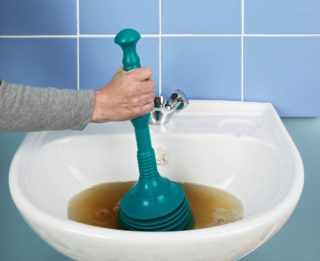 Plunger - the easiest option. It works on the principle of a pump, pumping water and dirt out. Good for recent deposits.
Plunger - the easiest option. It works on the principle of a pump, pumping water and dirt out. Good for recent deposits.
To clean, do the following:
- fill the sink or bath with hot water;
- cover the drain hole with a plunger;
- without tearing the device, 15-20 times vigorously press and pull the handle;
- repeat the procedure if necessary.
Plumbing cable. The most effective cleaning option, but also the most time-consuming. It is a flexible wire with a diameter of 3-4 mm., With a handle on the end. The work must be carried out together.
Execution Sequence:
- remove the siphon to access the sewer;
- shove the working end of the cable into the pipe;
- push it further while turning the handle;
- periodically remove the cable from the pipe to clean it;
- repeat the procedure until you get the result.
These methods can be combined. To save time, it is advisable to immediately determine the appropriate one.
How to choose a suitable method
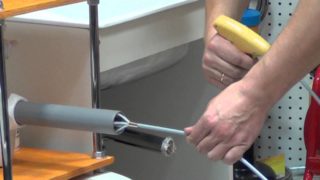 The cleaning method depends on the nature of the contamination and the material of the pipes.
The cleaning method depends on the nature of the contamination and the material of the pipes.
Chemical works well when the pollution is small. Otherwise, the substance simply dissolves in stagnant water and does not give the desired effect. But it requires careful use, especially in rooms with children. It is not valid for metal pipes.
Cleaning with a plunger is used for fresh small blockages. It is convenient and safe, but requires some effort. The farm should have several plungers: one for the sink and bath, the other for the toilet. This is necessary for hygiene.
A plumbing cable is the most radical way to clean. It requires removal of the siphon. On the other hand, it fights well with old deposits and is suitable for all types of pipes. When choosing, pay attention to its tip. To eliminate deposits, it should be in the form of a wire ruff, and to remove foreign objects - in the form of a spiral. If a funnel forms during draining, cleaning is complete.
Prevention
But no matter how easy it is to clear the blockage with modern methods, it is much easier to avoid it. To do this, follow a few simple rules:
- do not throw large insoluble waste into the sewer;
- wash greasy dishes with plenty of water;
- every 2 months, rinse the drains with boiling water;
- use strainers and fat separators;
- periodically fill the system with cleaning chemicals.
Thus, it is possible to clean sewer pipes from deposits on their own. But if the blockage cannot be eliminated on its own, you can always contact specialized companies.

